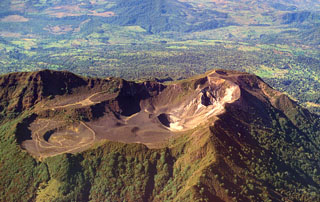Report on Turrialba (Costa Rica) — 14 September-20 September 2016
Smithsonian Institution / US Geological Survey
Weekly Volcanic Activity Report, 14 September-20 September 2016
Managing Editor: Sally Sennert.
Please cite this report as:
Global Volcanism Program, 2016. Report on Turrialba (Costa Rica) (Sennert, S, ed.). Weekly Volcanic Activity Report, 14 September-20 September 2016. Smithsonian Institution and US Geological Survey.
Turrialba
Costa Rica
10.025°N, 83.767°W; summit elev. 3340 m
All times are local (unless otherwise noted)
OVSICORI-UNA reported that starting at 0210 on 13 September ash emissions from Turrialba rose 300 m and drifted NNW. A small explosion was detected later that day at 1947. Small explosions were detected at 1804 and 2147 on 15 September. On 16 September small explosions were recorded at 0240, followed by three periods of passive ash emissions. An explosion at 1100 on 16 September generated an ash plume that rose 50 m above the crater and likely drifted S (inclement weather prevented visual observations). Ashfall was reported in the Parque Nacional Braulio Carrillo, and areas E of San José and Heredia including Ipís de Guadalupe.
A series of gas-and-ash emissions began at 0958 on 17 September with an ash plume that rose 400 m above the crater and drifted NW. Plumes the rest of the day did not exceed that height, though an explosion at 2148 generated a plume that rose 500 m. Ash-and-gas emissions were recorded on 18 September; some plumes were observed rising as high as 500 m, although inclement weather hindered most observations. Explosions during four energetic periods on 19 September generated ash plumes that rose as high as 4 km. A sulfur odor and ashfall was reported in many communities in the Valle Central including those in San José (35 km WSW), Heredia (38 km W), Alajuela, and Cartago (25 km SW). According to news articles, flights in and out of the Juan Santamaría International Airport were canceled; the airport remained closed at least through the morning of 20 September. The Pavas San José Tobías Bolaños Airport was also temporarily closed. At night during 19-20 September ash emissions rose as high as 500 m and drifted WNW. Ash plumes during the rest of 20 September rose as high as 700 m. Plumes drifted NW and NE.
Geological Summary. Turrialba, the easternmost of Costa Rica's Holocene volcanoes, is a large vegetated basaltic-to-dacitic stratovolcano located across a broad saddle NE of Irazú volcano overlooking the city of Cartago. The massive edifice covers an area of 500 km2. Three well-defined craters occur at the upper SW end of a broad 800 x 2200 m summit depression that is breached to the NE. Most activity originated from the summit vent complex, but two pyroclastic cones are located on the SW flank. Five major explosive eruptions have occurred during the past 3500 years. A series of explosive eruptions during the 19th century were sometimes accompanied by pyroclastic flows. Fumarolic activity continues at the central and SW summit craters.
Sources: Tico Times, Observatorio Vulcanologico y Sismologico de Costa Rica-Universidad Nacional (OVSICORI-UNA), Stuff

